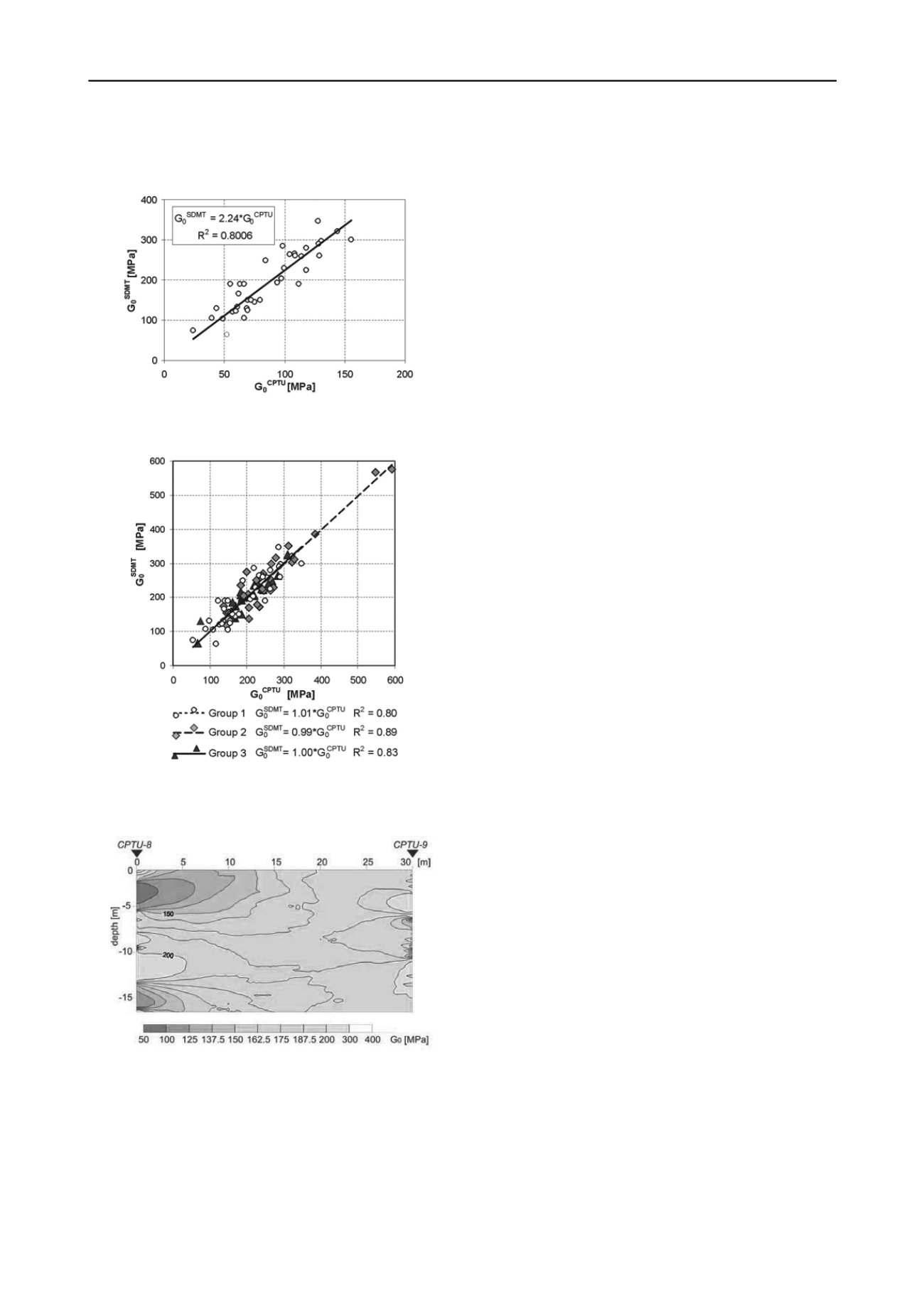
586
Proceedings of the 18
th
International Conference on Soil Mechanics and Geotechnical Engineering, Paris 2013
Group 3
G
0
= 41,20
q
t
+ 0,37
G
v0
+ 0,88 OCR – 28,53
(9)
Figure. 9. Relationship between shear modulus G
0
DMT
and G
0
CPTU
Figure 10. Relationship between measured G
0
DMT
and G
0
CPTU
after the
calibration.
Figure 11. The model of subsoil stiffness calculated on the G
0
values
from CPTU, calibrated by SDMT results.
In order to obtain a continuous picture of changes in the shear
modulus G
0
the dependence of G
0
CPTU
was calibrated using
measured values of G
0
DMT
(Fig. 10). Moduli G
0
CPTU
determined
from this relationship may be used in the construction of a
model of rigidity for the subsoil composed of soils of varied
genesis. An example of such a model for the foundation of a
wind turbine is presented in Fig. 11. The model was constructed
using Inverse Distance Weighting Method (IDW) according to
Młynarek et al. (2007).
5
CONCLUDING REMARKS
On the basis of the conducted investigations it may be
concluded that the simultaneous use of CPTU and SDMT
provides a continuous picture of changes in rigidity of subsoil
composed of soils with diverse genesis. The effectiveness of
these methods is emphasized by the high statistical evaluation
for the dependence between deformation and shear strength
moduli from both tests. However, to determine this dependence
it is necessary to apply a calibration function. The calibration
function needs to be specified for the soils, which should be
grouped depending on their grain size, since this variable also
influences relationships between parameters measured in CPTU
and SDMT.
After calibration this relationship may be a useful tool in the
construction of a model for rigidity of subsoil based on shear
strength moduli G
0
or M
0
moduli.
6
REFERENCES
Hegazy Y.A. & Mayne, P.W. 1995. Statistical correlations between Vs
and CPT data for different soil types.
Proc. of Symposium on Cone
Penetration Testing
, Vol. 2:173-178.Swedish Geotechnical Society:
Linköping.
Jamiolkowski M., Lancellotta R., Lo Presti D.C.F. 1995. Remarks on
the stiffness at small strain of six Italian clays.
International
Symposium on Pre-failure Deformation Characteristics of
Geomaterials
. Hokkaido vol.2: 817-836.
Lechowicz Z., Rabarijoely S., Galas P., Kiziewicz D. 2011. Settlement
evaluation of spread foundations on heavily preconsolidated
cohesive soils.
Annals of Warsaw University of Life Sciences –
SGGW, Land Reclam.Nr. 43 (2,) pp.113-120.
Lee S. H. H., Stoke K. H. 1986. Investigation of low amplitude shear
wave velocity in anisotropics materials.
Geotechnical Report No.
GR 86-6
, Civil Engineering Department, University of Texas,
Auatin.
Lunne T., Robertson P. K., Powell J.J.M. 1997.
Cone Penetration
Testing in Geotechnical Practice
, Blackie Academic &
Professional.
Marchetti S., Monaco P., Calabrese M., Totani G. 1999. The flat
dilatometer test. A report to the ISSMGE Committee TC-16.
Mayne P.W. 2000. Stress-Strain-Strength-Flow Parameters from
Enhanced In-Situ Tests.
Proc. International Conference on In-Situ
Measurement of Soil Properties and Case Histories
, Bali,
Indonesia: 27-48.
Młynarek Z. 2003. Influence of quality of in-situ tests on evaluation of
geotechnical parameters of subsoil.
Proc. of 13
th
European
Conference on Soil Mechanics and Geotechnical Engineering.
Prague.
vol.3.
Młynarek Z., Wierzbicki J., Wołyński W. 2007. An approach to 3-
subsoil model based on CPTU results.
Proc. of 14th European
Conference on Soil Mechanics and Geotechnical Engineering
,
Madrid.
Sanglerat G. 1972.
The penetrometer and soil exploration.
Elsevier,
Amsterdam.
Tanaka H., Nishida K. 2007. Suction and shear wave velocity
measurements for assessment of sample quality.
Proc. of the 3
rd
International Workshop on in-situ tests and sample disturbance of
clays.
Studia Geotechica et Mechaica No. 1. Technical University ,
Wrocław.
Wierzbicki J. 2010. Evaluation of subsoil overconsolidation by means
of in situ tests at the aspect of its origin. (in Polish).
Rozprawy
Naukowe nr 410.
Wydawnictwo Uniwersytetu Przyrodniczego w
Poznaniu. ISSN 1896-1894, 182 pp.


